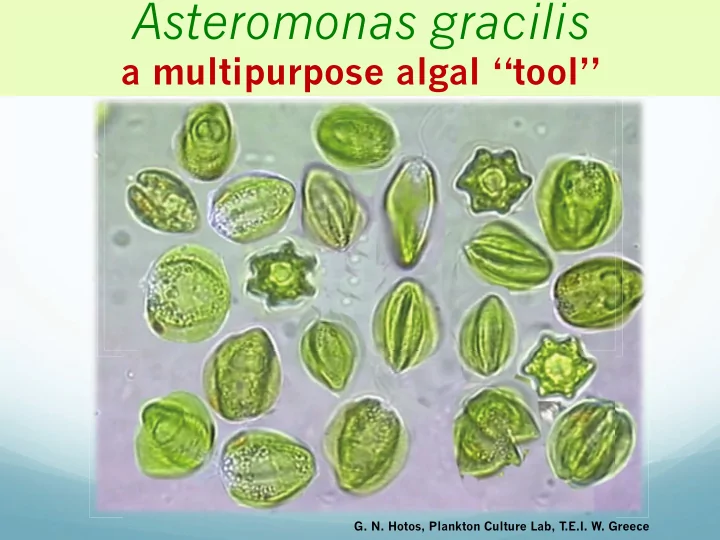

Asteromonas gracilis a multipurpose algal “tool” G. N. Hotos, Plankton Culture Lab, T .E.I. W. Greece
“Who is who” of Asteromonas gracilis An extremely halotolerant green wall-less microalga with an appealing appearance Kingdom: Protista Phylum: Chlorophyta Class: Chlorophyceae Order: Chlamydomonadales Family: Asteromonadaceae Genus: Asteromonas Species: Asteromonas gracilis (Artari) Size range: 18 – 25 m G. N. Hotos, Plankton Culture Lab, T .E.I. W. Greece
“Three of a kind” Asteromonas-Dunaliella-Tetraselmis In the salterns ponds thrive the three halotolerant green microalgae, Asteromonas gracilis, Dunaliella salina, Tetraselmis marina Dunaliella salina Tetraselmis marina G. N. Hotos, Plankton Culture Lab, T .E.I. W. Greece
A. gracilis is found in extreme salinity (tolerates 25-300 ppt) Exhibiting the most amazing polymorphism among microalgae G. N. Hotos, Plankton Culture Lab, T .E.I. W. Greece
Survival strategies of Asteromonas gracilis When its living medium worsens, e.g. depletion of nutrients, it sum up in peculiar lumps. G. N. Hotos, Plankton Culture Lab, T .E.I. W. Greece
or, transforms into cysts that remain viable for months or years G. N. Hotos, Plankton Culture Lab, T .E.I. W. Greece
and when nutrients are restored, it “wakes up” and multiplicates fast G. N. Hotos, Plankton Culture Lab, T .E.I. W. Greece
CULTURE CONDITIONS Can be grown easily needing: A medium amount of light (~2000 lux or more) No vitamins Moderate aeration and in small volumes none Salinity from 25 ppt to 300 ppt Temperature from 10 to 35 o C Practically unaffected in a wide pH range (7-9) With a very short lag phase With a very long healthy stationary phase Can be kept in moist salt for years G. N. Hotos, Plankton Culture Lab, T .E.I. W. Greece
“The problem of monoculture ” When Asteromonas is mixed with other species in a culture vessel e.g. Rhodomonas salina, Tetraselmis suecica, Isochrysis galbana and Dunaliella salina G. N. Hotos, Plankton Culture Lab, T .E.I. W. Greece
All begin normally at 30 ppt salinity G. N. Hotos, Plankton Culture Lab, T .E.I. W. Greece
But as salinity is raised gradually above 80 ppt … All other species except Asteromonas (and Dunaliella ) start suffering …. G. N. Hotos, Plankton Culture Lab, T .E.I. W. Greece
And eventually above 100 ppt start to die out G. N. Hotos, Plankton Culture Lab, T .E.I. W. Greece
Only Asteromonas and Dunaliella (if present) survive above 130 ppt G. N. Hotos, Plankton Culture Lab, T .E.I. W. Greece
To be the “super star” of the culture G. N. Hotos, Plankton Culture Lab, T .E.I. W. Greece
And if happened to be “forgotten” for a year.. or so.. in pure salt .. Its cysts although decolorized in the dark, due to loss of pigments, remain alive G. N. Hotos, Plankton Culture Lab, T .E.I. W. Greece
It “wakes up” after watering, lighting and addition of nutrients G. N. Hotos, Plankton Culture Lab, T .E.I. W. Greece
And through greening … G. N. Hotos, Plankton Culture Lab, T .E.I. W. Greece
Becomes the Asteromonas we want to see … G. N. Hotos, Plankton Culture Lab, T .E.I. W. Greece
What we actually get from Asteromonas? It is a big easily observable microalgae, ideal for teaching It moves slowly and gracefully, trackable microscopically It endures every salinity from 25 ppt and up It is hardy, growing with minimum of prerequisites Its culture practically “never” collapses It can be kept unattended for years in moist salt Can get rid of other species by increasing salinity It is an all purpose effective food for filter feeders A promising candidate for culture in hypersalinity G. N. Hotos, Plankton Culture Lab, T .E.I. W. Greece
Who eats Asteromonas? Rotifers, Brachionus plicatilis Protozoa various species Euplotes Protozoa , Fabrea salina , Condylostoma sp, Oxyrrhis sp Copepods , Tisbe sp And of course Artemia G. N. Hotos, Plankton Culture Lab, T .E.I. W. Greece
Studying the minute algae (e.g. Nannochloropsis oculata ) is an ordinary case G. N. Hotos, Plankton Culture Lab, T .E.I. W. Greece
But studying… with Asteromonas becomes more educationally fun .. G. N. Hotos, Plankton Culture Lab, T .E.I. W. Greece
And by raising salinity to 100 ppt even the hardy Nanno succumbs ... G. N. Hotos, Plankton Culture Lab, T .E.I. W. Greece
Thank you Search YouTube for: “ Dr G. Hotos Lab, Greece ” to enjoy Asteromonas and her companion in motion .. G. N. Hotos, Plankton Culture Lab, T .E.I. W. Greece
Recommend
More recommend